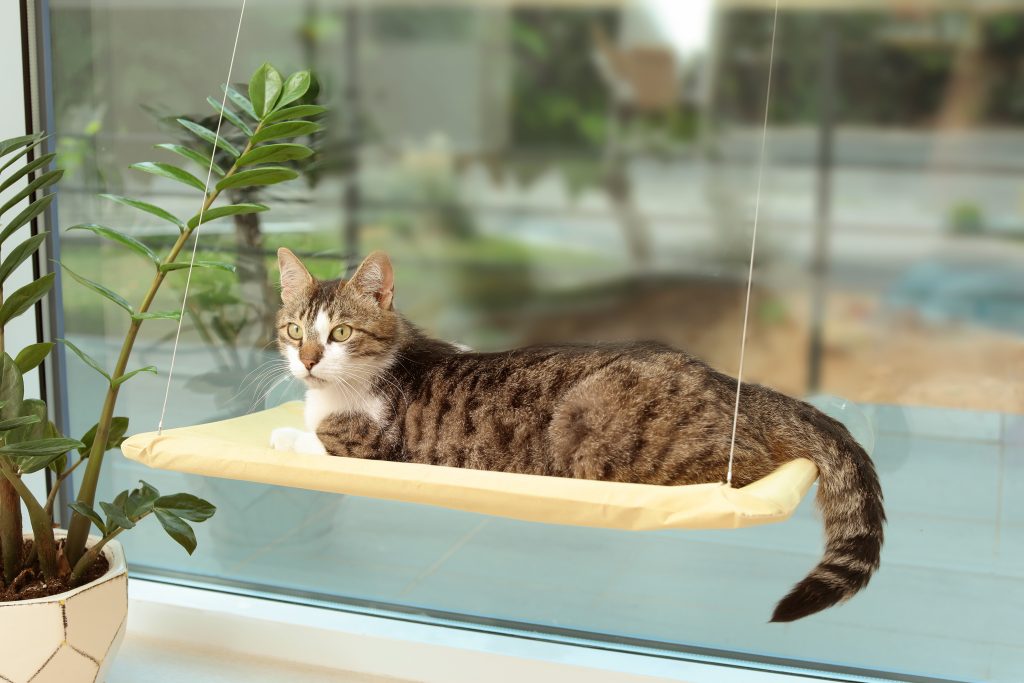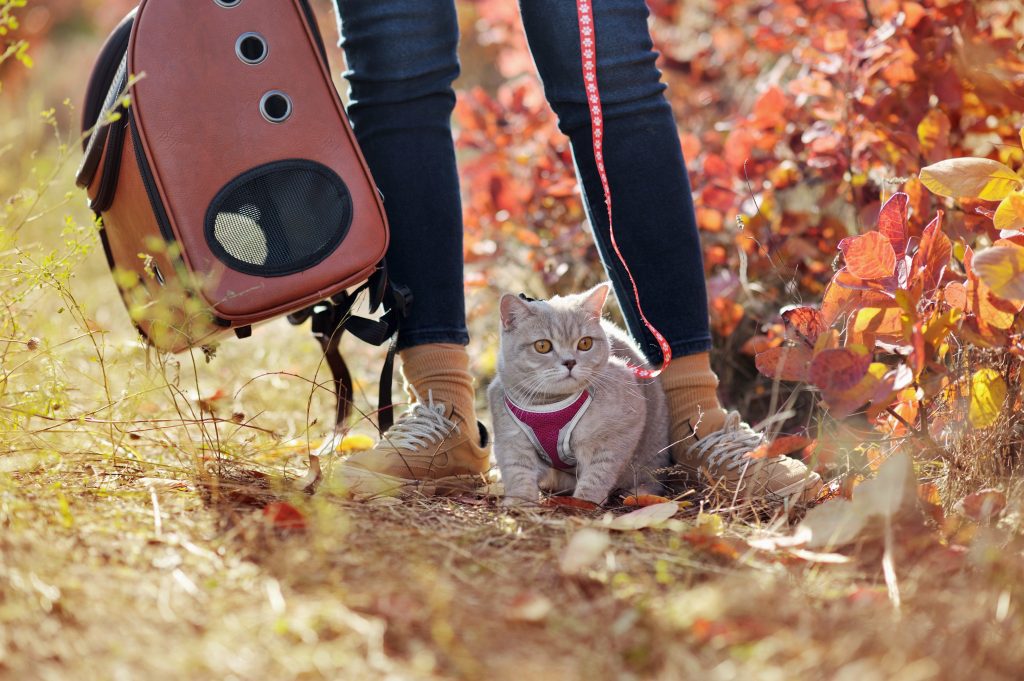RVing with Cats: Tips, Tricks, and Essential Gear
At RVnGO, we know how important it is that your fur babies go along with you on your travels whenever possible. Traveling in an RV with your cats can be a wonderful and rewarding experience. With some careful planning and consideration, you can create a comfortable and enjoyable environment for both you and your feline companions.
In this comprehensive guide, we’ll cover everything you need to know about RVing with cats, from preparing your RV and keeping your cats safe, to maintaining their well-being and ensuring a smooth journey.
Preparing Your Cat for RV Life
For a smoother transition into RV life, keep these tips in mind.
Gradual Introduction to the RV
- Start early: Introduce your cat to the RV several weeks before your trip. Allow them to explore and get comfortable with the new space.
- Create positive associations: Use treats, toys, and praise to help your cat associate the RV with positive experiences.
- Short trips first: Take your cat on short drives to acclimate them to the motion and sounds of the RV.
Training and Socialization
- Harness and leash training: Train your cat to wear a harness and walk on a leash. This allows for safe outdoor exploration during your travels.
- Recall training: Teach your cat to come when called, ensuring they can be easily retrieved if they venture too far.
Preparing Your RV for Your Cats

Before you hit the road, it’s important to prepare your RV to make it as cat-friendly as possible. Here’s what you should consider:
Packing Essentials for RVing with Cats
Don’t forget to pack these essential items for your feline companions:
- Food and treats
- Water and food dishes
- Litter and litter box
- Toys and scratchers
- Grooming supplies
- Cat carrier and harness
- Any necessary medications
Creating a Safe Space
Provide your cats with a dedicated, secure area where they can feel safe and comfortable. This could be a crate or a cozy nook, complete with a soft bed, food, water, and toys. Make sure it’s well-ventilated and accessible for your cats at all times.
Customizing a Cat Area
Create an inviting space for your cats by adding some of their favorite items, such as blankets, beds, and toys. Consider incorporating shelves, ramps, or perches to provide them with vertical spaces to climb and explore.
Installing window perches or shelves for your cat is another great way to enrich their environment. This way, they can enjoy the views and sunbathe on the go.
Litter Box Solutions
Choose a convenient and discreet location for the litter box, such as under a bench or in a storage compartment. Opt for a high-quality, odor-controlling litter and clean the box regularly to maintain hygiene and reduce smells. More on managing a litter box in an RV can be found later in this article.
Cat-Proofing Your RV
Inspect your RV for any potential hazards and ensure all loose items are secure. Remove toxic plants, cover electrical cords, and use childproof latches on cabinets to prevent your cats from accessing dangerous items.
Window Safety
Ensure that all windows and screens are secure and that your cats cannot escape or become injured by falling. Install window guards or adjustable screens to allow for ventilation while maintaining safety.
Preparing Your Cats for Long Drives

Before setting off on a long journey, it’s important to help your cats become accustomed to the sensation of being in a moving vehicle. Here are some steps to take:
Gradual Exposure
Start by taking your cats on short drives in the RV, gradually increasing the duration and distance over time. This will help them become more comfortable with the sounds, vibrations, and movement of the vehicle.
Reward Positive Behavior
Reward your cats with treats, praise, and affection for remaining calm and relaxed during drives. This will reinforce their positive association with the RV and make them more likely to enjoy future trips.
Familiar Scents
Bring along items that carry the scent of your home, such as blankets, beds, or toys. Familiar scents can help your cats feel more secure and comforted during the journey.
Plan Your Route and Stops
Plan your route ahead of time, factoring in regular stops for your cats to stretch, eat, and use the litter box. Look for pet-friendly campsites, rest areas, and attractions to ensure a welcoming environment for your cats during your travels.
Keeping Cats Entertained on the Road

Long drives can be boring for both humans and cats. To keep your feline friends entertained during the journey, try the following:
Interactive Toys
Bring a variety of toys that will engage your cats’ natural instincts to hunt, stalk, and chase. Examples include feather wands, laser pointers, and treat-dispensing toys.
Rotating Toys
Rotate your cats’ toys every few days to maintain their interest and prevent boredom.
Playtime
Schedule regular play sessions with your cats throughout the day. This will help them burn off energy, reduce stress, and strengthen your bond.
Health and Wellness on the Road
In addition to ensuring your cats’ safety and comfort, it’s important to maintain a healthy environment for them in the RV. Here are some tips:
Proper Ventilation
Keep your RV well-ventilated by opening windows and using fans to promote air circulation. This will help maintain a comfortable temperature and reduce odors.
Cleanliness
Regularly clean the RV’s interior, including floors, surfaces, and bedding, to minimize pet hair, dander, and allergens. Use pet-friendly cleaning products to ensure your cats’ safety.
Regular Health Checks
Monitor your cats’ health throughout the trip by regularly checking for any signs of illness or discomfort. Keep an eye on their appetite, water intake, and litter box habits to ensure they remain in good health.
Veterinary Care
- Pre-trip checkup: Schedule a veterinary visit before your trip to ensure your cat is healthy and up-to-date on vaccinations.
- Pet insurance: Consider investing in pet insurance to cover unexpected veterinary expenses while traveling.
Medications and Supplements
- Pack all medications: Bring any prescribed medications or supplements your cat needs, along with a copy of their prescription.
- Motion sickness prevention: Consult your veterinarian for recommendations on medications or
Cat Safety While on the Road

Once your RV is cat-friendly, prioritize your cats’ safety during your travels:
Secure Your Cats While Driving
To keep your cats safe while the RV is in motion, consider using a cat harness and leash, or placing them in a secure carrier. This will prevent any accidents or escapes when you open the door or stop for a break.
Carrier Safety
Choose a carrier that is the appropriate size for your cat, with enough space for them to stand up, turn around, and lie down comfortably. Secure the carrier in a stable location within the RV to prevent it from shifting or falling during transit. If possible, pick a carrier that has a soft lining on the inside for added comfort during long drives. Otherwise, use a small towel, blanket, or articles of clothing to keep your cat as comfortable as possible.
Microchipping and Identification
Ensure your cats are microchipped and have up-to-date identification tags with your contact information. This will help reunite you with your cats in case they get lost or separated during your travels.
Emergency Preparedness
Assemble a pet first-aid kit and familiarize yourself with basic cat first-aid. Keep your cats’ vaccination records and a list of nearby veterinarians handy in case of emergencies.
Maintaining Cat Comfort and Well-Being
To make the journey enjoyable for your feline friends, consider the following:
Maintaining Routine and Familiarity
Try to maintain your cats’ normal routines for feeding, playtime, and grooming. Bring along familiar items such as toys, blankets, and beds to help your cats feel more at ease.
Monitoring Stress Levels
Monitor your cats for signs of stress or anxiety, such as excessive grooming, hiding, or aggression. If needed, consider using calming aids like pheromone sprays or anxiety vests to help your cats feel more relaxed.
Signs of Stress in Cats
Be aware of the following signs of stress in cats:
- Excessive vocalization
- Aggression towards humans or other pets
- Loss of appetite
- Litter box avoidance or accidents
- Hiding or seeking isolation
- Excessive grooming or hair loss
If needed, consider using calming aids like pheromone sprays, anxiety vests, or calming treats to help your cats feel more relaxed.
Introducing Calming Techniques
Introduce calming techniques gradually before your trip, allowing your cats to become familiar with and adjust to any new items or practices. Experiment with different methods to find the most effective approach for your individual cats.
Exploring the Great Outdoors with Your Cats

If your cats enjoy the outdoors, here’s how you can make the most of your adventures together:
Leash Training and Outdoor Safety
Introduce your cats to a harness and leash to ensure they remain secure and under control when exploring outside. Keep a close eye on them and be mindful of potential dangers, such as other animals, plants, or insects. Using a cat backpack to take your cats outdoors safely.
Cat Enclosures and Playpens
Consider investing in a portable cat enclosure or playpen, which allows your cats to safely experience the outdoors while being protected from potential threats.
Managing a Litter Box in an RV
Managing a litter box in an RV can be challenging, but with some careful planning and creative solutions, you can maintain a clean and odor-free environment. Here are some tips to help you manage your cats’ litter box:
Selecting the Right Litter Box
Choose a litter box that suits the available space and your cats’ preferences. Enclosed litter boxes can help contain odors and prevent litter from being scattered, while open litter boxes may be more appealing to some cats. Consider a top-entry litter box to minimize tracking and spillage.
Using Odor-Controlling Litter
Opt for an odor-controlling litter, such as clumping clay, silica gel, or wood pellets, to help minimize smells. Experiment with different types to find the one that works best for you and your cats.
Maintaining Litter Box Hygiene
Clean the litter box regularly, removing soiled litter daily and fully replacing the litter at least once a week. Use a litter box liner or a non-stick coating to make cleaning easier.
Managing Litter Box Smells
To control odors, use a high-quality, clumping litter and clean the box at least once a day. Consider using a litter deodorizer or an air purifier to further reduce smells.
Litter Box Alternatives
For extended trips or limited space, consider using disposable litter boxes or a portable, self-cleaning litter box system.
Conclusion
RVing with cats can be a fun and rewarding experience. However, it requires careful planning and preparation to ensure your cat’s safety and comfort. Designate a safe spot for your cat in your RV, pack their essentials, and be mindful of their needs during the trip. Follow these tips and tricks to make your RVing journey with your furry friend enjoyable and stress-free.